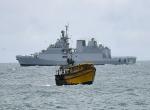Activities of the People’s Liberation Army Navy (PLAN)
China along with Vietnam is the largest claimants of islands in the South China Sea. China has built military bases to include berthing sites for war ships, air strips for fighter and transport aircraft and is keen on optimising the resources of the region. Recently there are transgressions by Chinese in Vietnamese waters which we would analyse but prior to that we must examine Chinese maritime outreach in the Indo Pacific region. It is pertinent to note that the PLAN operates in conjunction with the Chinese Coast Guard and civilian merchant ships. But the distinction may be blurred with regard to current intentions.
China’s decision to enhance its maritime capabilities and move toward the ocean-centric strategic thinking is to enhance its capability to project its economic and military muscle beyond its shores. China today is an arms exporter to many Asian and African countries. It has also started exporting ships, warships and military aircraft to a sizeable number of countries. It is in this context it would be important to list the naval facilities it is developing in the Indian Ocean. Having gained tremendous experience in building military facilities in the Spratly and Paracel islands in the South China Sea China has now expanded its forays beyond the Malacca, Sunda and Lombok Straits. China is also expanding its maritime aspects of the Belt Road Initiative which would see investments in ports, roads and other infrastructure mainly in Asia and Africa. The Chinese Navy has been active in anti-piracy mission in the Gulf of Aden and has performed creditably against pirates in the Western Indian Ocean.
David Brewster, in an article which appeared in lowyinstitute.org on 30 January 2018, had written about China’s new network of Indian Ocean Bases. He gives details about Chinese initiatives in this field. The first overseas base that China opened was at Djibouti in July 2017. The base has got facilities comprising a naval port, large helicopter base and accommodation for 10000 troops. Its establishment was a big step for Beijing which had long decried foreign bases as the domain of Western powers. The question which is being asked is the reason China selected Djibouti as a Base? The answer is:-
- The move is uncontroversial given the existing presence of French, US and Japanese forces.
- Makes a good hub for supporting China’s anti-piracy operations in the Arabian Sea and Chinese United Nations peace keeping operations in Africa.
- It would be a good staging point for civilian evacuations.
- Will assist any future Chinese military operations in Africa and the Middle East.
The Djibouti base is only the first step to a network of bases China is planning in the Indian Ocean. The next base that China is planning is at Gwadar in Pakistan. Gwadar would have a naval port, an airport and accommodation for about 500,000 Chinese personnel many of them would be possibly Marines. The accommodation would come up in about five years. Gwadar’s present population is about 100,000 and this would be turned into a Chinese colony in Pakistan. Meanwhile, in January 2018, a United States Report claimed that China is about to start construction of a new naval base and airfield at Jiwani, which is about 60 Km from Gwadar. This has not been confirmed by Beijing but Jiwani currently holds a Pakistani base and old airfields which could be expanded and used by the Chinese Air Force. Further, Gwadar could be used for commercial purposes and Jiwani, could be a military base.
In the central Indian Ocean China, recently took control of the port of Hambantota. The Sri Lankan Government has formally stated to the Government of India that no naval facilities would be permitted there. However, the Chinese are adept at doing things with intelligence and often civil facilities could be put to military use.
The next area pertains to the country of Maldives. Maldives is currently facing political problems and the previous President has reportedly sold a large number of islands to China. Though India remains an important player, the Chinese are slowly building facilities which could be used by their naval ships.
China is building a deep water seaport at Kyauk Pyu in Myanmar. The port, with the help of a pipe line, will pump oil to the Yunnan province of China. Further, a Special Economic Zone will be constructed here. This would cover an area of 4200 acres (17 square km). The investment would be $ 7.3 billion for the port and a $ 2.3 billion for the industrial park. The industrial park would in all probability have an oil refinery and textile industries. Construction is expected to begin in full swing this year subject to signing of agreements.
China intended to build a deep sea port at Sonadia near Cox’s Bazar in Bangladesh. China had prepared the Detailed Project Report but the same has been cancelled by the Bangladesh Government due to lack of commercial viability. It is pertinent to note that the Japanese would be building a port at Matarbari which is 25 km away from Sonadia. The cancellation of Sonadia project appears to be a strategic decision by Bangladesh which has the possible backing of the United States, Japan and India as reported by Indrani Bagchi in the Times News Network update on 08 February 2016 (available online timesofindia.indiatimes.com).
The same article refers to India being offered the Payra Port close to Chittagong. The feasibility study is being undertaken and it will take seven years to build. Though Bangladesh receives weapons from China she has currently prevented port facilities being built by it.
Having observed the Chinese forays in the Indian Ocean, it would be pertinent to examine the recent intrusion by Chinese in the South China Sea.
Transgressions by China in South China Sea
Like all major powers, China is looking for measures to increase her oil resources, which are reported to be in abundance in the South China Sea. China continues to persist on the U shaped 9-Dash line on the South China Sea as their territory. As per reports (www.reuters.com), a Chinese oil exploratory ship, The Hayang Dizhi 8, entered an area near Vanguard Bank which is a part of Exclusive Economic Zone of Vietnam on 04 July 2019. The survey ship was escorted by two Chinese coast guard ships which were destroyers. These were followed closely by four Vietnamese coast guard ships which were again destroyers. One of the oil blocks surveyed is licensed by Vietnam to Spanish energy firm Respol (REP>MC). The Spanish Company was pressurised by China in 2017 and 2018, and as a result, they ceased their operations.
It would be pertinent to relate to a previous incident which occurred a few days prior to the current one. In this case, the Chinese Coast Guard Ship Haijing 35111 manoeuvred in a threatening manner towards Vietnamese vessels servicing a Japanese owned oil rig, the Hakuryu-5, leased by Russian state oil firm Rosneft, in Vietnam’s Block 06.1, 370 Km (230 miles) South East of Vietnam. The vessels passed within 100 m from each other and the situation was precarious. As per the Press Trust of India report of 29 July 2019, Vietnam briefed India about the escalating tension in the South China Sea and about Chinese intrusions in their EEZ. This also impacts India’s oil projects in the region.
Besides India, Vietnam has also reached out to US, Russia, Australia and several other leading players against the Chinese action which appeared to be aimed at disrupting oil exploration projects in Vietnamese waters.
Way Ahead
The South China Sea (referred to as the East Sea by Vietnam ), The Sea of Japan and the islands therein form the first chain of islands which China is trying to dominate as a launch pad for its future strategic and economic operations. The area is extremely rich in hydro-carbons and China treats these areas as critical for its Comprehensive National Power. China has not bothered about the UN Convention on the Law of The Sea or about the Permanent Court of Arbitration Ruling. Amongst the claimants only Vietnam is contesting the Chinese manoeuvres and is capable of fighting it out if push comes to shove. Vietnam is also considering judicial options which would be of no consequence to China.
India has rightly spoken of freedom of navigation in international waters which is a step in the right direction. India has its oil blocks in the South China Sea and is an intense strategic partner of Vietnam. Indian Naval ships must have shore facilities in Cam Ranh Bay, Danang and Vungtau to enable them to patrol our oil blocks in the South China Sea sporadically. This would give strength to the phrase ‘India-Pacific’ and possibly send signals to China to resist transgressions. The United States must also patrol the area to ensure that navigation international waters are not disturbed. Meanwhile, China’s misadventures have to be resisted by Vietnam with patience and determination.
(The paper is the author’s individual scholastic articulation. The author certifies that the article/paper is original in content, unpublished and it has not been submitted for publication/web upload elsewhere, and that the facts and figures quoted are duly referenced, as needed, and are believed to be correct). (The paper does not necessarily represent the organisational stance... More >>
Image Source: https://cdn.images.express.co.uk/img/dynamic/78/590x/1163555_1.jpg?r=1565296177267











Post new comment